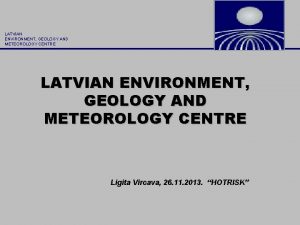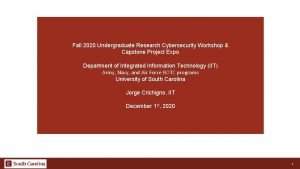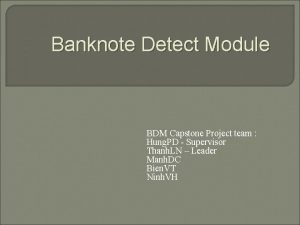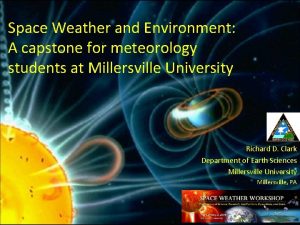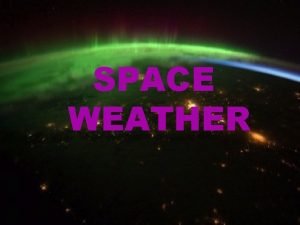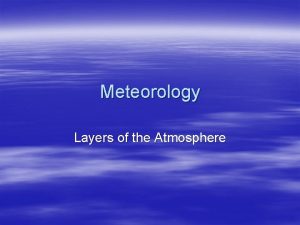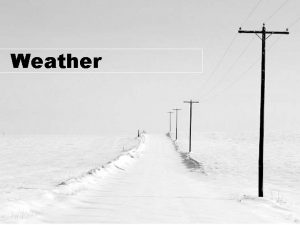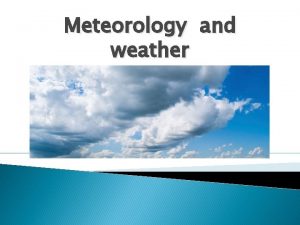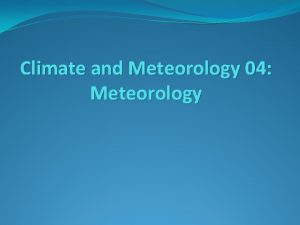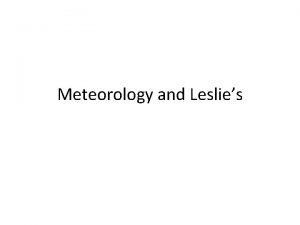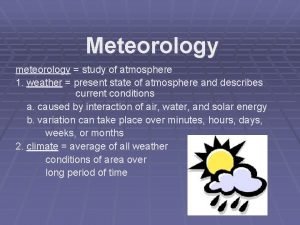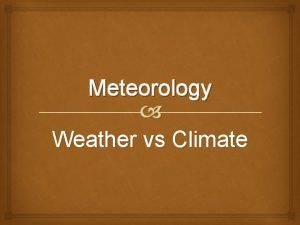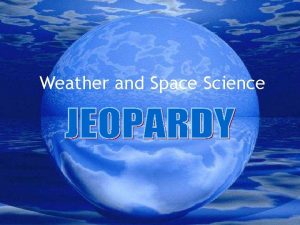Space Weather and Environment A capstone for meteorology


















- Slides: 18

Space Weather and Environment: A capstone for meteorology students at Millersville University Richard D. Clark Department of Earth Sciences Millersville University Millersville, PA

“There is beauty in space, and it is orderly. There is no weather, and there is regularity. It is predictable…Everything in space obeys the laws of physics. If you know these laws and obey them, space will treat you kindly. ” - Wernher von Braun There is beauty in space, and its order and regularly has seeded our understanding of the laws of physics, which we employ to learn, describe, and predict. But it is also catastrophic and we are the beneficiaries of many catastrophes. If we are to progress as a space venturing, technological society, we must understand predict these catastrophes. - von Braun admirer

Why the interest in Space Weather? At the level of undergraduate education There is deep and expanding interest in the emerging field of space weather because of the influence radio blackouts, solar radiation storms, geomagnetic storms have on satellites, communications, power grids and pipelines. The National Space Weather Program began in 1994 in response to community efforts to highlight the strategic nature of space science research with the aim of addressing increasing needs to specify (observe) and predict conditions in space. The field is new, inherently interdisciplinary, and ripe with opportunity, where individuals can make significant contributions to science and society. The American Meteorological Society began sponsoring an international conference on Space Weather 4 years ago as venue for dissemination of research activities. Recent policy statement on SW.

DRAFT AMS Policy Statement on Space Weather Summary Statement The American Meteorological Society (AMS) recognizes the importance of space weather research and services, and the need to develop advanced forecasting and mitigation techniques. Because of our increasing reliance on technologies susceptible to space weather and the demonstrated importance of space weather to society, the AMS strongly endorses activities and investments that further our understanding of this cross-disciplinary science and its practical applications. Recommendation Universities should broaden their meteorology curricula to include space weather and its effects.

Rationale for Undergraduate Course in SW 1) expose students to the origins of space weather, properties/characteristics of the Sun, heliosphere, magnetosphere, ionosphere, and upper atmosphere, solar-terrestrial connections, and current state of observations and forecasts, 2) provide students with the conceptual, visual, observational, mathematical, and physical framework for understanding the space environment, predicting space weather, informing SW policy.

I v. D = (F x B)/q. B 2 Drift Velocity – perpendicular to B Gravity Field F = m g v. D = (mg x B)/q. B 2

ESCI 440: Space Weather and Environment • Credits/Contact hours: 3/3 • Course Type: Elective for Meteorology and Physics Majors • Catalog Description: In-depth study of the space environment between Earth and Sun; solar-terrestrial interactions; physics of the Sun and space weather; observations, modeling, and prediction of space weather events; effects on life, property, and infrastructure. • Co-requisite: MATH 365; Pre-requisites: ESCI 342, and either ESCI 340 or PHYS 233; or permission of the instructor • Text: Space Weather: the physics behind the slogan by • K. Scherer (Editor), H. Fichtner (Editor), B. Heber (Editor), U Mall (Editor)

PRIMARY COURSE OBJECTIVES 1. Demonstrate an understanding of the structure, composition, energy transfer processes, solar cycles, and evolution of the Sun. 2. Explain mathematically and conceptually the fundamental principles governing electric, magnetic, electromagnetic fields, plasma, and gas kinetics. 3. Define space weather and comprehensively describe examples of space weather events and impacts of space weather on ground- and space-based technical systems. 4. Elucidate relationships between space weather and natural climate forcing. 5. Analyze observational data and model output of the space environment and space weather events – storms, plasma clouds, CMEs. 6. Interpret observational data and model output of the space environment and space weather events – storms, plasma clouds, CMEs. 7. Characterize the physical properties of the heliosphere, magnetosphere, ionosphere, thermosphere. 8. Describe and run space physics models in predictive and diagnostic modes. Visualize model output. Discuss model uncertainty. 9. Orally communicate scientifically and technically on issues related to space science. 10. Discuss the specifications, space environment sensor suite, and measurement capabilities of NOAA and NASA satellites. 11. Use technology appropriate to the course. 12. Describe the impact of space weather on life, property, and infrastructure.

Comprehensive Outline of Course Content 1. 2. 3. 4. 5. 6. 7. 8. Introduction to Space Weather and the Solar-Terrestrial Environment Living with a Star The Physics of Space Weather a) Electric and Magnetic Fields b) Electromagnetic Theory The Solar Interaction with the Interplanetary Medium c) Charged Particle Motions a) ZAMS-to-present: Evolution i) magnetic force. Solar on a charged particle and the H-R diagram The Earth’s Magnetosphere a) What ii)is Space motion in a. Weather? uniform magnetic field b) Structure of the Solar Interior a) Heliosphere The Earth’s Ionosphere/Thermosphere iii) gyrofrequency and helical motion b) Origins of Weather a)c)The Shape of. Space the Magnetosphere iv) total force. P-P on a particle (Lorentz force) Walk; Convection Energy Release: Cycle; Random b) Solar Wind Space Weather Observation, Modeling and Prediction v) particle drifts and collisions c) A retrospective of the U. S. National b)d)Ionospheric/Thermospheric Regions of Atmosphere the Magnetosphere Layers Space Weather Program The. Activity: Solar c) a) Solar Flares, of the Prominences, vi) magnitude magnetic moment Sunspots; Spicules, Plages, etc. d) Overview of space weather effects on technologies. Currents c) Allen Belts Space Weather Effects on Life, Property and Infrastructure vii)Radiation particle trajectories b) Ionospheric Densities, Conductivities, Temperatures, a) d) Real-time Space Weather Data Sources e)Van In situ Observations of the Sun in H ; Observations at other Wavelengths Solar Energetic Particles (SEPs), Coronal Holes, and Coronal Mass Ejections (CMEs) viii) magnetic mirroring e) Space weather forecasting: A grand challenge d) Magnetospheric Waves c) Ionospheric Convection – Harang Discontinuity i) In-situ data: ix) the loss cone Suomi. Net - Total Ionospheric Electron Density f) Solar Cycles a) Space Weather Events f) Space weather: Lessons from x) adiabatic invariants (1 st, 2 nd , 3 rd) the meteorologists e) The Dynamic Magnetosphere d)g) Aurora ii) Ground-based Observations Solar i) Radio Radiation Blackouts Storms and Geomagnetic Storms d) Magnetic Force f) Terrestrial Effects ofdensity Magnetic Storms e) Ionosphere/Thermosphere Modeling i) magnetic force iii) Solar Space/Satellite-based observations ii) Radiation Storms ii) magnetic tension and pressure gradient forces b) Space Weather Modeling and Prediction iii) Geomagnetic Storms iii) magnetic force balance iv) plasma momentum balance i) Overview ofcurrents model characteristics b) Space Weather Effects v) equilibrium e) Frozen-Field Theorem on Communication ii) Magnetosphere Modeling Systems i) Effects i) magnetic flux tubes iii) NCAR Community-based ii) Satellite Systems Failures ii) Ohm’s Law for a magnetized plasmathermospheric-ionospheric global models iii) current sheetsweather models iv) NASA space iii) Ground-Based Electric Power Grids f) Static/Neutral Atmospheres c) Runningiv)Space Weather in Real-Time i) the fluid Currents element. Models Induced in Long Conductors: Effects on Pipelines ii) pressure gradient force i) Prediction and Diagnosis Surveys of Space Weather Events using Models v) Effects on Geomagnetic iii) tenuous gases iv) gas pressure and temperature vi) Effects on Navigation Systems v) force balance and scale height and differences vii) Hazards to Humans in Space

Course Resources COMET© Modules 1. Space Weather Welcome 2. Space Weather Basics 3. In-Depth Physics Lessons 4. Physics of the Aurora: Earth Systems

Course Resources • USAF Manual: Handbook of Geophysics and Space Environment • SWPC Web Site • HAO Web Site – Web Casts and Access Grid • National Ground-based Solar Observatories • Space-based Observing Platforms – Solar and Heliospheric Observatory (SOHO) – Solar TErrestrial RElations Observatory (STEREO)

Millersville University SA 05 Suomi. Net Site

Course Resources H Observations using the Coronado© Solar Max 40

Space Weather Data and Products http: //www. swpc. noaa. gov/ • Alerts and Forecasts • SWPC Reports and Summaries • Space Weather Models – – – D-region Absorption Prediction STORM Time Empirical Ionospheric Correction Model US Total Electron Content Map - USTEC Costello Geomagnetic Activity Index--Pred. Kp The Wang Sheeley Model Relativistic Electron Forecast Model • Solar and Geomagnetic Indices • Instrument Measurements

Seminars • Live video/audio broadcasts from HAO via Access Grid in 2006 -07 – cost prohibitive w/o organizational commitment • Future Streaming media options – Web Conferencing (2 -way audio plus presentation on PC) – Webcasting (1 -way, no interaction, no real-time) – Access Grid (2 way, real-time, resource issues) • Access important – being discussed by NCAR Web Advisory Group Subcommittee on Next Generation of Streaming Media

Course Improvements • More time devoted to describing the impact of space weather on life, property, and infrastructure • Elucidate relationships between space weather and natural climate forcing • Greater use of models, and offer students the ability to run models • Greater integration of the use of Mat. Lab for class assignments • An active Sun

Future plans for Space Weather at MU More seminars (guest speakers and streaming) Run our own models on an enhanced cluster Engage students in SW research Seek internships/collaboration for students interested in SW • Design and construct a solar observatory in our new building • •

Thanks Richard. Clark@millersville. edu Also, see poster presented by the eight students in SW&E for their take on this course
 Latvian environment, geology and meteorology centre founded
Latvian environment, geology and meteorology centre founded Environment of business finance
Environment of business finance Weather station model practice
Weather station model practice Tongue twisters about winter
Tongue twisters about winter Clothes poem
Clothes poem Its stormy
Its stormy Whether the weather is fine or whether the weather is not
Whether the weather is fine or whether the weather is not Heavy weather by weather report
Heavy weather by weather report Capital weather gang weather wall
Capital weather gang weather wall Experience in culminating activity
Experience in culminating activity Middle school capstone project ideas
Middle school capstone project ideas Capstone project outline example
Capstone project outline example Capstone tracking
Capstone tracking Enrollment system capstone
Enrollment system capstone Cyber security capstone project
Cyber security capstone project Culinary capstone project ideas
Culinary capstone project ideas Wharton business foundations capstone
Wharton business foundations capstone Bdm capstone project
Bdm capstone project How to use pasco capstone
How to use pasco capstone
